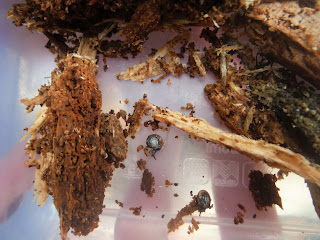We have some wonderful big logs in our kindergarten
playground that the children use to climb on and jump off. They are used to
foster imaginary play as the children turn them into castles, boats, forts and
so on. We love our logs as they support our children’s learning and development
in so many complex ways; physically, emotionally, socially, as well as
providing a direct opportunity for the children to connect with nature in a fun
and dynamic way.
Lately one of our logs (a large piece of kahikatea) has created another
learning path as we discovered that it was starting to rot. When it was
revealed that the wood was quite soft the children, Christine and I started to
scratch around. At this stage in the experience Christine and I could have
shut down the learning that could come about from this due to the rotten wood
being a risk in our environment. Instead of this we both embraced this treasure
that had been found and began encouraging the children involved to explore,
question and think about what they were finding. This is what we refer to as a ‘teachable
moment’ and is something that we like to utilise in our work with children.
“Teachable
moments are times when something unexpected occurs and the teacher helps to
guide the unexpected occurrence into a learning opportunity. “Pre-schoolers are discovering the world around
them. Their natural curiosity and need-to-know creates many opportunities for
teachable moments. The teacher has to develop a teaching perspective in order
to not miss out on unexpected learning opportunities. Every preschool teacher
should have an understanding of what a teachable moment is and how to look at
every moment from a teaching perspective.” (Stewart, 2009)
This lead to some great findings, most excitingly was the unearthing of
what we thought were baby kauri snails. The children were so engaged as they carefully started to pull away the rotting wood, closely sifting through the
pieces for these precious snails. After finding about twenty of the snails, it
was decided that we needed to do some more research about what to do next.
Christine contacted DoC who informed us that they wouldn’t be kauri snails as
they don’t live in logs, however they would be a native New Zealand snail that should
be returned to native bush if possible. After doing some more research on
native snails of New Zealand it was discovered that there was thousands to
choose from.
Alongside the inquiry of finding out more about the snails, some of the
children also started to embark on representing their findings through drawing
and the use of clay.
They shared their thinking about how the snails made their
way to kindergarten saying things like,
“Well I think they slide from Auckland, but a person had to pick them up
and drive them some of the way because it is long from Auckland. They dropped
them at kindergarten. The gate was locked but they are so small they just
slided right under and came to our log.” (Franchi)
It was lovely hearing the children sharing their thoughts and ideas with
each other during this process.
This rotting log also created a scenario that required a ‘health and
safety’ assessment as the rotting wood was a place where the children like to
climb and play. After completing a hazard report we came to the conclusion that
the learning and engagement that was happening around the log was very
beneficial for the children involved. Therefore, instead of placing a cordon
around the area and not letting the children go near this space until we had
‘removed’ the hazard, we decided to celebrate this happening. Yes, now this area was full of more potential risks when children were playing there, however we know that great learning can come from letting children be involved with their own risk assessment.
The children
helped make ‘be careful’ signs, outlining the fact that it wasn’t ok to walk
or jump on top of the log. We discussed what was happening at group times and
reminded the children while they were playing in the area to be mindful of the
rotten wood. By this hazard being monitored and managed in this way, the flow
on effect was that the children were able to explore, engage and interact in
meaningful ways with such a wonderful natural resource. I love the fact that I
work amongst a team of teachers that embrace experiences like this, rather than
instantly shutting things down.
“Risky
play is an invaluable part of childhood. Research shows that not only does it
increase children’s physical and motor skills but also teaches them about their
own limits, and how to deal with risks in the future. Children´s safety however
is an ever increasing issue that some teachers are anxious about. This worry
about children injuring themselves (or others) during risky play is preventing
some children from having the opportunity to engage in such activities. Thus,
it is important that teachers provide children with an environment where they
can engage in risky play that is as safe as necessary rather than as safe as
possible… The more children are free to engage in risky play the better they
will be at managing risks, judging what they are capable of, and keeping
themselves safe. The role of the teacher is to provide a challenging and risky
learning environment that will support all children as they become more
motivated, curious, able, and adventurous.” (Wilkinson, 2015)
After the children have finished showing an interest in this rotten log,
our plan is to get it removed. This is also exciting as it is going to open up
a new place that we can plan and play with to create a new and inspiring play
space.
Hei
konā mai,
Zair

































1 comment:
That is so cool, the children are so lucky to have such inspiring and inspired teachers!
Post a Comment